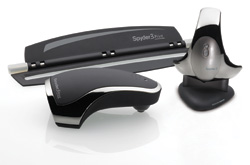Datacolor Spyder3Studio
COMLETE COLOR MANAGEMENT SYSTEM
 Spyder3Studio is an easy-to-use, comprehensive solution for producing an accurate, predictable color workflow—from calibrating and profiling your display to building excellent paper profiles. The package contains the new Spyder3Elite colorimeter and software for monitor calibration and Spyder3Print spectrophotometer and software for profiling paper.
Spyder3Studio is an easy-to-use, comprehensive solution for producing an accurate, predictable color workflow—from calibrating and profiling your display to building excellent paper profiles. The package contains the new Spyder3Elite colorimeter and software for monitor calibration and Spyder3Print spectrophotometer and software for profiling paper.
You can use the Spyder3Elite to calibrate LCDs, CRTs, laptops, and projectors. Compared to its predecessor (Spyder2), the Spyder3Elite is 37% smaller, uses more sensitive sensors, and has a larger aperture for collecting light from your display. The colorimeter monitors room light using an ambient light sensor located on its back. Like the Spyder2, Spyder3 uses a seven-channel, seven-filter, optical engine. The Spyder sits in a handy desktop cradle that can be mounted on a tripod to facilitate calibrating projectors. To hold it in place for measuring, it has a removable suction cup for CRTs and a counterweight on its cord for LCDs.
Online documentation helps you make informed decisions as the software guides you through its steps. If your monitor provides access to controls, you can manually adjust brightness, contrast, and RGB color sliders during calibration; otherwise, you can select from a list of presets. I used 2.2 gamma, 6500K color temperature, and 110 luminance. When finished calibrating and profiling, there’s a handy before-and-after image file that lets you compare your results.
The Spyder3 is much faster than its predecessor. It has a recalibrate feature that cuts the process time in half; but are the final results better than its predecessor? When I compared Spyder2 against Spyder3, I didn’t see a dime’s worth of difference. So if you already own a Spyder2, you might not want to upgrade.
The second part to the Studio is Spyder3Print, which does an excellent job of simplifying the process for building quality, custom color and black-and-white ICC paper profiles. There’s a world of great third-party papers to explore from companies such as Hahnemühle, Moab, and Red River, but printer manufacturers like Epson, HP, etc. include profiles for their papers only, and buying good customized profiles for third-party papers can cost up to $100. Studio3Print goes a long way to clear up any confusion that arises when profiling third-party papers—when you’re asked to select from a list of media presets (made up of only the manufacturer’s papers) in your print driver. In other words, which one of their papers is similar to the third-party paper you’re profiling? For example, I found when profiling Moab Fine Art papers that using Epson’s Premium Presentation Paper as a preset was optimal.
The Spyder3Print software supplies targets made up of 150 to more than 729 rows and columns of color patches, with an extended target for building black-and-white profiles. Usually the more patches, the more precise the profile; however, I used the target with 225 patches and got quality profiles. After letting the paper dry, you read the patches with the spectrophotometer. Datacolor includes a guide device that facilitates moving the spectrophotometer over the patches. You must read each patch individually, however, which can be tedious and lead to errors. The software lets you know if you mistakenly skipped over a patch and lets you correct for it.
I hope with Datacolor’s next version that gliding or skimming the spectrophotometer over a row of patches in a single movement will replace the current method—saving time and mistakes—but if matching prints to your display is a priority, Spyder3Studio has the tools for the job.
—Steve Baczewski
PRICE: $599
FROM: Datacolor
WEB: www.datacolor.com
RATING: 4
LAYERS VERDICT
HOT Affordable, comprehensive, accurate color-management tools
NOT Very difficult getting through to tech support
